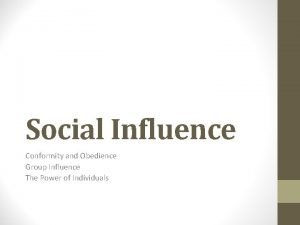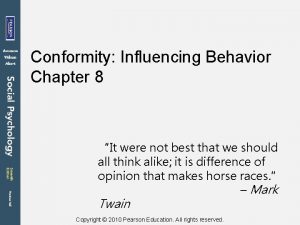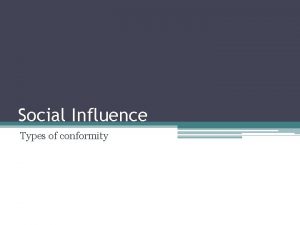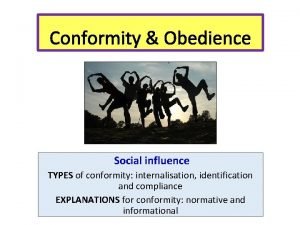SOCIAL PSYCHOLOGY SOCIAL INFLUENCE PSYA 2 Conformity to








- Slides: 8

SOCIAL PSYCHOLOGY: SOCIAL INFLUENCE PSYA 2

Conformity to majority influence Criticisms of Asch’s Research Individual Differences • Females are more likely to conform as • The findings could be said to unique to one experiments were conducted by males who culture (all participants were American men) Why did people Kelman proposed threedifferences types of conformity: were more likely toconform? find gender • Distortion of perception – began to see the lines the same way as the majority than women Compliance – going along withtheir others to gain their approval. • The was conducted a period Distortion of judgement felt doubt about ownexperiment judgement so went along within the • • Females complied more – because they majority of others strong anti-communist feeling where were confident, not – because they were less Internalisation going along with because you have • Distortion of action – the majority of participants who were did conform own opinion people afraidknew to betheir different more conformist accepted their view point astoitavoid is consistent own. was correct but gave incorrect answers disapprovalwith from your the group Variations in the study: Evaluating Research into Conformity Identification – going along with • others you was have accepted Anotherbecause similar study carried out in the • Difficulty of the task – Asch made the differences in the line length smaller so the correct • Validity – participants had to but answer outbecause engineering students their point of view only of with a desire toincreased. be like them. and out of answer was more difficult. This led to the level 1970’s of conformity being loud in front of a group, even though the 396 only 1 participant However • Lucas al found that when people were exposed to maths problems, conformed. high-self efficiency task wasetinsignificant and easy they may another study was carried out onwith youths on remained more independent than low-self efficiency participants when presented a have conformed so they were accepted by ASCH (Research into majority influence) where the are confederates harder task. This shows that task difficulty andprobation, individual differences important in were the • Asch group. show volunteers the diagram on the right officers and the level of conformity. probation • determining It could be argued that conformity takes • Heof asked the participants which line was the same Size the ‘special majority conformity was similar to what Asch found place under circumstances’ • Asch found there was very little conformity when the group size was small (one/two). Under as the standard line the pressure of adidn’t large group to 30%. • Participants know the thatconformity all other rose people inbe theremembered that only 1/3 of Ethics • It must unanimity of the group were ‘confederates’ • The Asch’s participants did majority not know the real trials gave a conforming answer so 2/3 • When the task was repeated with 2 real participants the conformity level dropped to 5. 5% purpose the experiment andofdidn’t know • Aschoffound that 36. 8% the responses made wereoriginal decision despite the stuck to their Conclusion theconforming group were with confederates. Deception the confederates giving the wrong answer Asch concluded that it was the and lack of informed consent. breaking of the groups consensus that was the major factor in conformity reduction.

Conformity to minority influence Explaining Minority The Lessons of Minority Influence Moscovici. Conformity et al proposedto that if a minority were consistent in their views, the consistency will create conflict in the rest of the group, leading it to question and possibly change it’s existing views. Influence Research Procedures. Theory Moscovici 1) The minority can actively promote a differing Conversion viewpoint, butgroup need 2 towere be consistent in that if He tested groupsonofthe 6 women, ofifthe in the confederates andviewpoint 4 Moscovici’s theory 32 is based idea that an 6 participants they are to succeed. Without consistency, real participants individualwere is exposed to an argument that is internalisation is unlikely. contradictory to an attitude that 36 is already The group was shown differentheld, bluethis slides (they were told the experiment was about colour 2) Eventhey withsaw) consistency and commitment, minorities creates conflict. Conversion assumes that and perception and theory were asked to describe the colour often do not prevail as the person holding the individuals are motivated to reduce conflict, 1 and st or 2 nd, or 1 st and 4 th) consistently reported that the The two confederates (whothis answered minority viewpoint is often disliked and rejected by will therefore the minorities arguments in slidesexamine were green order to understand why people do not hold the same members of the majority. In another part of this experiment the confederates answeredtoinconsistently andpoint saidstimulates green 24 those 3) Exposure a minority view opinions as the majority. As a result, when a minority times and blue 12 times of the majority to become better and more creative attempts to put across it’s argument, the attention is problem solvers as they search for information on all Findings on the content of the argument rather than the sides of the issue. Minority influence is therefore a relationship between agreed them and the group. Increasing Participants with the minority on 8. 42% of the slides valuable process. the likelihood they will internalise their ideas. 32% gave the same answer as the minority at least once Validity When is internalisation more likely? When participants were inconsistent the agreement was reduced to 1. 25% ‘Real World’ validity has shown that minority influence In-group minority – are people who are similar to the is relatively rare and the majority view has a much When participants were allowed write down answer there wasthat more majority, they have a greater influence ontothe public. their bigger This Out-group minority are confederates people who are agreement with–the as different they were reluctant toinfluence. be seen as partcan be seen in politics where many discussions take place but rarely anything is fromof the majority, havein aspublic. much, if not more the deviantcan minority changed. influence when responses are made in private Ethics Both can lead to internalisation but effect may be masked when it is an out-group as people may not It was necessary to deceive the participants about the

Explanations of why people conform Normative Social Influence It is possible to behave like the majority without accepting their view. This type to conformity is called compliance. A majority may be able to control other group members by making it difficult for them to deviate from the majority view, putting pressure on them to conform. Going against the majority isn’t easy, demonstrated in Asch’s study where the participants felt awkward about having a different answer from the group. Humans are a social species whom have a fear of rejection. This forms the basis of normative social influence. Informational Social Influence In some cases individuals go along with others because they believe they are right. As a result we do not just comply, but also change our own point of view. This involves changing public and private attitudes it is internalisation. Informational social influence is most likely when: The situation is ambiguous – i. e. The right course of action is not clear. The situation is a crisis – i. e. Rapid action is required We believe others to be experts – i. e. We believe that others are more likely to know what to do Wittenbrink and Henly found that participants who were exposed to a negative image of African Americans later reported more negative beliefs about a black target individual.

Obedience to Authority Milgram’s Study of Obedience Conclusions Ethical Issues of the Study These findings that ordinary people are people Milgramdemonstrate set out to investigate whether ordinary will obey a and legitimate even when Deception lackauthority of informed consent astonishingly obedient authority, even when asked to required to to injure an innocent person. Milgram deceived his participants by telling them that behave in an inhumane manner. Suggesting that people they were involved in a study of the effects of Procedures who commit crimes are not evil, but simply obeying y punishmentmin rather than telling them the ter Stud enlearning, e i r h t e p f orders. 40 male participants o recruited advertisingtofor ex real e purpose. to take part in a study in how thvolunteers dity were ali. Obedience e ain, it u V p d Situational Factors in n t i a s h punishment effects leaning at Yale was dt were$4. 50 even if they left the study. r’ wa to m withdraw? ne. University. e. Right ypaid e rn. Everyone tiothe h s a t e e t l ‘ u Milgram carried out 18 different of a Realisvariations q h e et ev. Milgram’s en th and eople lm li. In was not clear toalways what extent son. . it. The hstudent’ rstudy pthe ethe w e There were some two confederates ‘the ‘experimenter’ confederate b e p t ’ m r n o e obedience experiment, of variations are a d i h c S t d o o e s the opl he must participants felt that they had the right toeach withdraw. ended up as the was electric shocks to the learner time aining He e toadminister nt petold g a described below: a e remteacher. m m a e d r e t o v n a couldeach be argued the prods the h a question wrong onsa increase learner got a from question in m thethat ifica which would This Proximity ofhe thegot victim: igntask, could ccur time o y y n l a a ing‘teacher’ilwas wrong. variations ce m ospita it difficult for some participants y forcedobtoedienexperimenter hmade t In one of Milgram’s i causthe a n b i t a u s e choice but to continue. liplate, who felt they ahad hno hat tthe ied o nd the erareceived lity to nshock iup arrand hold the ‘learners’ handshocks onto awere here ’ b c h i The (fake) 315 volts at this point ‘learner’ banged on the wall t i s s Ge s a m o w S p r y e d D e ‘ h u t h t Protection from psychological harm t y t s of obedience rate toon 30% tes/ said tnothing ed b anddropped from then s, a % n g 5 Todid o n 9 i h o. t t t p e le s n’t attacked, saying it put the study atien Proximity of the authority figure: werewas alistic ses were te ug to a p. Milgram’s y e r e h s t aseries If the ‘teacher’ questioned experiment the ‘experimenter’ gave of prods, strain, such as ‘it is wgreat urthe a drif the participants under emotional caused ge a ough e Nfull a e h t Only 21% of participants went shock level s v i o n htoerthe g d e w o v t e e h t m go on’ or d havepsychological absolutely essential that ‘you no choice, youdamage must gotoon’. e. Some them. It has also been ed thyou experimenter was in a different people ne and questeeven o e r h askroom. p s a e h d i t d r argued that administering the shocks can activate a gave the. Findings smallest shock repeatedly ns ovethe nurseswithout otelling i t. c e u l t r t t s o previously dormant aspect of an individuals experimenter. take in hat on the b t asked psychiatrists, personality Before the experiment, Milgram college students and his colleagues to itpredict and make them want to do again. Increasing the teachers discretion: double how far his participants would go before they refused. They expected very few to go on past In a variation where the ‘teachers’ were allowed to Why was the research subject to 150 only 4%one to reach 300 volts. in 1000 were expected to go to the full 450 volts. choose theirvolts ownand shock only participant out of 140 65% of the 95% participants went to the full criticism? 450 volts, and all participants went to 300 volts. delivered the. However maximum shock. of participants The findings were so shocking as they challenged refused to go on after the ‘learner’ refused for the first

Explanations of why people obey Why do people obey (Milgram) Gradual commitment – as participants have already given lower level shocks, it becomes hard to resist the experimenters requirement to increase the shocks as the experiment continues. No shock administered is ever more that 15 volts more than the previous level. This is a foot-in-thedoor method of persuasion. Agentic Shift – this is a state where ‘the condition a person is in when he sees himself as an agent for carrying out another person’s wishes’ the individual comes to see themselves as an agent for executing the wishes of another. The role of buffers – when the learner was in the same room the effect of buffers was reduced, as was the tendency to obey the commands of the experimenter. Justifying obedience – when people were told to continue by offering an ideology (good for science, threat to national security etc) people were more likely to continue as they believed they were serving a justifiable cause. Criticising Milgram’s Explanation of Obedience Monocausal emphasis - Mandel suggests that by focusing solely on obedience as an explanations for atrocities carried out in the Holocaust, Milgram ignored any other explanations. Agentic Shift – In the holocaust people carried out atrocities in months and years rather than in just half an hour in a lab experiment. Also Milgram’s participants were told, although the shocks may be painful, there will be no permanent tissue damage.

Independent behaviour: Resisting social influence Resisting Pressures to Conform Insights from Asch’s studies – the role of allies: Asch showed how introducing another confederate who supported the individual, caused conformity rates to plummet. If a supporter was introduced was seen as invalid (wearing thick lens glasses) and a support who was valid (normal vision) they both lowered conformity but the valid supporter had a bigger impact. Showing that the presence of an ally is helpful when they are perceived to offer valid support. Non-conformist Personality – Individuals who respond to the majority with independence tend to be unconcerned with social norms. Not conforming to a norm is usually a result of indifference towards the group norm. Such individuals are said to have an anti-conformity orientation to their personalities. Resisting Pressures to Obey Insights from Milgram’s studies - When the study was moved from Yale University to a downtown office, more people felt able to resist authority. This tells us that status is a key factor in obedience / resistance. Resistance was also increased when the victim could be seen, or when other confederates were present. This shows us that being made aware of the effects of your actions and having social support are means of increasing resistance. Moral Considerations - people were asked why people would behave in a certain way. Those who based their answers on general moral principles were more defiant in the study.

Individual differences in independent behaviour Locus of control- locus of control refers to a person’s perception of a personal control over their own behaviour. ‘High internals’ perceive themselves as having a lot of control over their own behaviour and are more likely to take personal responsibility. ‘High externals’ perceive their behaviour as being caused by more external influences or luck. 1) high internals – are active seekers of information that is useful to them, and so are less likely to reply on the opinions of others 2) high internals – tend to be more achievement-orientated and consequently are more likely to become leaders and entrepreneurs. 3) high internals – are better able to resist intimidation from others Americans are increasingly believing that their lives are controlled by outside forces than their own behaviour, as many people are believing that aspects of their lives are beyond their control. Attributional Style Attributional style is a personality attribute that indicated how people explain to themselves why they experience a particular event. Personal (dispositional vs. Situational) an individual may see themselves as the cause of an event or may attribute the event to cause to situational factors. ‘I failed my A-level because I am stupid’ (dispositional, internal) ‘I failed my A-level because I used the wrong text-book’ (situational, external) Permanent (stable vs. Unstable) ‘it’s pointless me trying again, I’ll just fail my A-levels’ (stable) or ‘Next time it'll be different’ (unstable) Pervasive (global vs. Local) ‘I can’t seem to do anything right’ or ‘Never mind I’ll concentrate on my other subjects’.
 Social thinking and social influence
Social thinking and social influence Social thinking social influence social relations
Social thinking social influence social relations Social thinking social influence social relations
Social thinking social influence social relations Examples of informational social influence
Examples of informational social influence What is informational social influence in psychology
What is informational social influence in psychology What is informational social influence in psychology
What is informational social influence in psychology Normative social influence ap psychology
Normative social influence ap psychology Conformity psychology
Conformity psychology Conformity psychology
Conformity psychology















